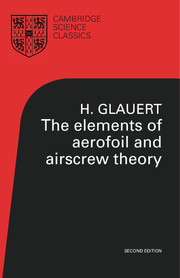Book contents
- Frontmatter
- PREFACE
- PREFACE TO SECOND EDITION
- Contents
- REFERENCES
- Chap. I Introduction
- Chap. II Bernoulli's Equation
- Chap. III The Stream Function
- Chap. IV Circulation and Vorticity
- Chap. V The Velocity Potential and the Potential Function
- Chap. VI The Transformation of a Circle into an Aerofoil
- Chap. VII The Aerofoil in Two Dimensions
- Chap. VIII Viscosity and Drag
- Chap. IX The Basis of Aerofoil Theory
- Chap. X The Aerofoil in Three Dimensions
- Chap. XI The Monoplane Aerofoil
- Chap. XII The Flow round an Aerofoil
- Chap. XIII Biplane Aerofoils
- Chap. XIV Wind Tunnel Interference on Aerofoils
- Chap. XV The Airscrew: Momentum Theory
- Chap. XVI The Airscrew: Blade Element Theory
- Chap. XVII The Airscrew: Wind Tunnel Interference
- Appendix
- Bibliography
- Index
Chap. IX - The Basis of Aerofoil Theory
Published online by Cambridge University Press: 01 June 2011
- Frontmatter
- PREFACE
- PREFACE TO SECOND EDITION
- Contents
- REFERENCES
- Chap. I Introduction
- Chap. II Bernoulli's Equation
- Chap. III The Stream Function
- Chap. IV Circulation and Vorticity
- Chap. V The Velocity Potential and the Potential Function
- Chap. VI The Transformation of a Circle into an Aerofoil
- Chap. VII The Aerofoil in Two Dimensions
- Chap. VIII Viscosity and Drag
- Chap. IX The Basis of Aerofoil Theory
- Chap. X The Aerofoil in Three Dimensions
- Chap. XI The Monoplane Aerofoil
- Chap. XII The Flow round an Aerofoil
- Chap. XIII Biplane Aerofoils
- Chap. XIV Wind Tunnel Interference on Aerofoils
- Chap. XV The Airscrew: Momentum Theory
- Chap. XVI The Airscrew: Blade Element Theory
- Chap. XVII The Airscrew: Wind Tunnel Interference
- Appendix
- Bibliography
- Index
Summary
The theory of the lift force given by an aerofoil in two-dimensional motion has been developed by considering the flow of a perfect fluid governed by Joukowski's hypothesis that the flow leaves the trailing edge of the aerofoil smoothly. It is necessary now to examine the fundamental basis of this theory and the extent to which the assumed motion represents the actual conditions which occur with a viscous fluid.
All real fluids possess the property of viscosity and the conception of a perfect fluid should be such that it represents the limiting condition of a fluid whose viscosity has become indefinitely small. Now it is well known that the limit of a function f(x) as x tends to zero is not necessarily equal to the value of the function when x is equal to zero, and hence, to obtain the true conception of a perfect fluid, it is not sufficient to assume simply that the coefficient of viscosity is zero. The viscosity must be retained in the equations of motion and the flow for a perfect fluid must be obtained by making the viscosity indefinitely small.
Slip on the boundary.
The first point to be considered is the motion of the fluid at the surface of a body. In a viscous fluid the relative velocity at the surface of a body is zero and the body is surrounded by a narrow boundary layer in which the velocity rises rapidly from zero to a finite value.
- Type
- Chapter
- Information
- The Elements of Aerofoil and Airscrew Theory , pp. 117 - 124Publisher: Cambridge University PressPrint publication year: 1983



